Critical Management Perspectives: Microsoft Workforce Diversity
VerifiedAdded on 2021/01/02
|12
|4034
|98
Report
AI Summary
This report provides a critical analysis of Microsoft's approach to workforce diversity, examining the challenges and opportunities the company faces in a global market. The report delves into the root causes of issues, particularly Microsoft's struggles in the mobile market, and evaluates the critical success factors for improving performance. It explores the impact of workforce diversity on innovation, teamwork, and market understanding, highlighting the significance of leadership, learning, and organizational culture. The analysis includes an examination of the post-modernization theory and its relevance to organizational culture changes, offering recommendations for Microsoft to enhance its strategies and achieve a competitive advantage. The report emphasizes the importance of a diversified workforce in formulating effective marketing strategies and catering to diverse customer needs. This assignment aims to provide a comprehensive overview of how Microsoft can leverage workforce diversity to overcome its market challenges and improve its overall success.
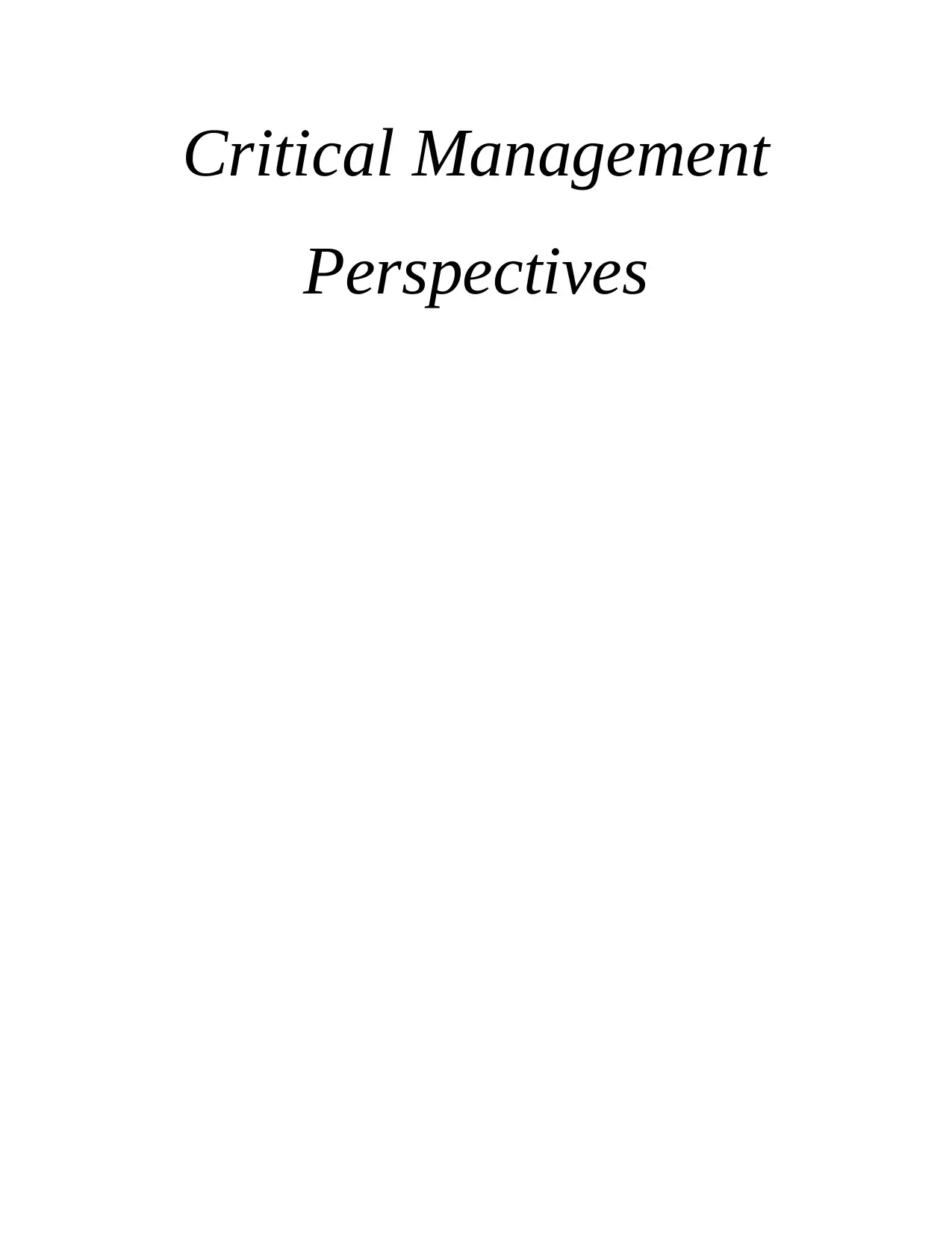
Critical Management
Perspectives
Perspectives
Paraphrase This Document
Need a fresh take? Get an instant paraphrase of this document with our AI Paraphraser
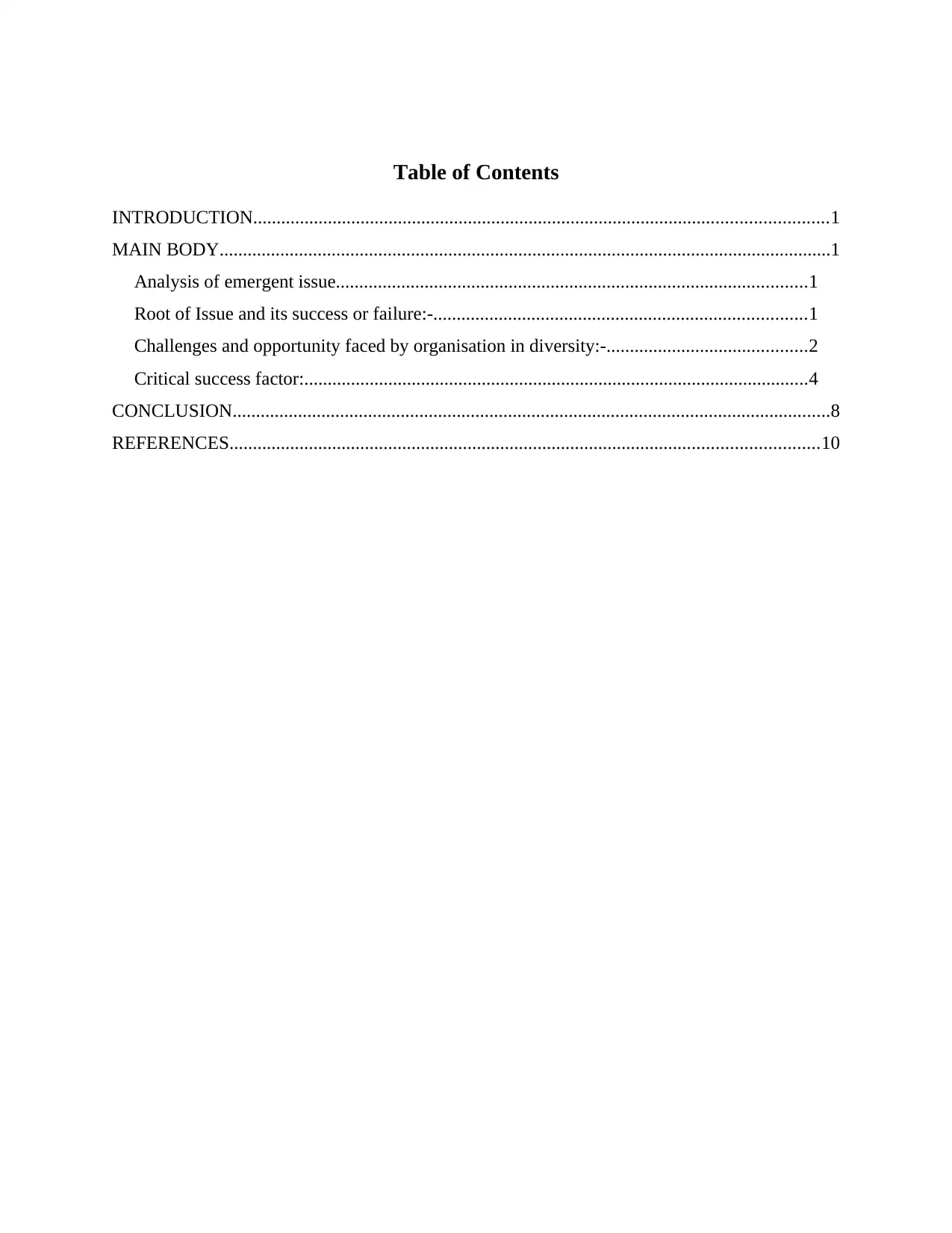
Table of Contents
INTRODUCTION...........................................................................................................................1
MAIN BODY...................................................................................................................................1
Analysis of emergent issue.....................................................................................................1
Root of Issue and its success or failure:-................................................................................1
Challenges and opportunity faced by organisation in diversity:-...........................................2
Critical success factor:............................................................................................................4
CONCLUSION................................................................................................................................8
REFERENCES..............................................................................................................................10
INTRODUCTION...........................................................................................................................1
MAIN BODY...................................................................................................................................1
Analysis of emergent issue.....................................................................................................1
Root of Issue and its success or failure:-................................................................................1
Challenges and opportunity faced by organisation in diversity:-...........................................2
Critical success factor:............................................................................................................4
CONCLUSION................................................................................................................................8
REFERENCES..............................................................................................................................10
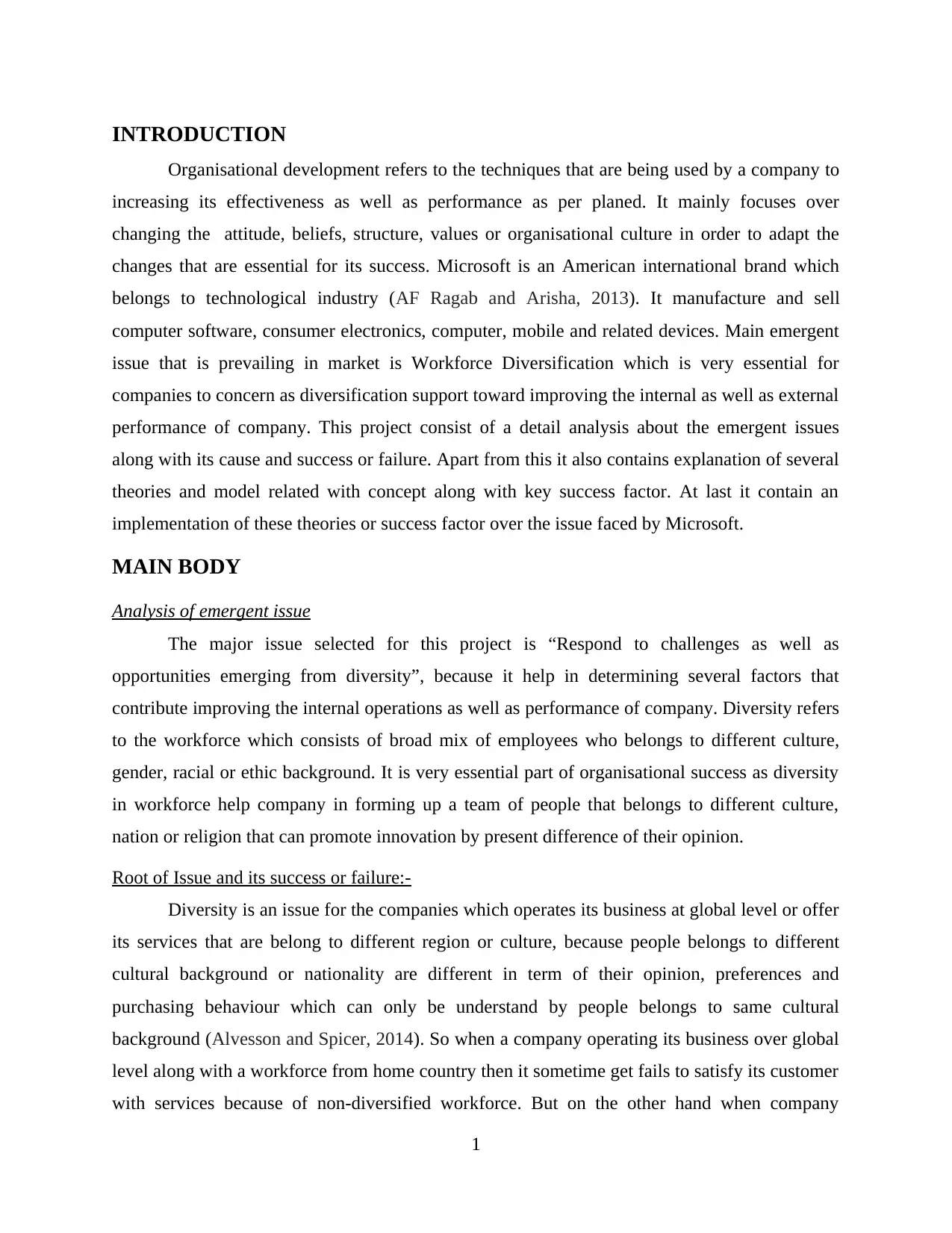
INTRODUCTION
Organisational development refers to the techniques that are being used by a company to
increasing its effectiveness as well as performance as per planed. It mainly focuses over
changing the attitude, beliefs, structure, values or organisational culture in order to adapt the
changes that are essential for its success. Microsoft is an American international brand which
belongs to technological industry (AF Ragab and Arisha, 2013). It manufacture and sell
computer software, consumer electronics, computer, mobile and related devices. Main emergent
issue that is prevailing in market is Workforce Diversification which is very essential for
companies to concern as diversification support toward improving the internal as well as external
performance of company. This project consist of a detail analysis about the emergent issues
along with its cause and success or failure. Apart from this it also contains explanation of several
theories and model related with concept along with key success factor. At last it contain an
implementation of these theories or success factor over the issue faced by Microsoft.
MAIN BODY
Analysis of emergent issue
The major issue selected for this project is “Respond to challenges as well as
opportunities emerging from diversity”, because it help in determining several factors that
contribute improving the internal operations as well as performance of company. Diversity refers
to the workforce which consists of broad mix of employees who belongs to different culture,
gender, racial or ethic background. It is very essential part of organisational success as diversity
in workforce help company in forming up a team of people that belongs to different culture,
nation or religion that can promote innovation by present difference of their opinion.
Root of Issue and its success or failure:-
Diversity is an issue for the companies which operates its business at global level or offer
its services that are belong to different region or culture, because people belongs to different
cultural background or nationality are different in term of their opinion, preferences and
purchasing behaviour which can only be understand by people belongs to same cultural
background (Alvesson and Spicer, 2014). So when a company operating its business over global
level along with a workforce from home country then it sometime get fails to satisfy its customer
with services because of non-diversified workforce. But on the other hand when company
1
Organisational development refers to the techniques that are being used by a company to
increasing its effectiveness as well as performance as per planed. It mainly focuses over
changing the attitude, beliefs, structure, values or organisational culture in order to adapt the
changes that are essential for its success. Microsoft is an American international brand which
belongs to technological industry (AF Ragab and Arisha, 2013). It manufacture and sell
computer software, consumer electronics, computer, mobile and related devices. Main emergent
issue that is prevailing in market is Workforce Diversification which is very essential for
companies to concern as diversification support toward improving the internal as well as external
performance of company. This project consist of a detail analysis about the emergent issues
along with its cause and success or failure. Apart from this it also contains explanation of several
theories and model related with concept along with key success factor. At last it contain an
implementation of these theories or success factor over the issue faced by Microsoft.
MAIN BODY
Analysis of emergent issue
The major issue selected for this project is “Respond to challenges as well as
opportunities emerging from diversity”, because it help in determining several factors that
contribute improving the internal operations as well as performance of company. Diversity refers
to the workforce which consists of broad mix of employees who belongs to different culture,
gender, racial or ethic background. It is very essential part of organisational success as diversity
in workforce help company in forming up a team of people that belongs to different culture,
nation or religion that can promote innovation by present difference of their opinion.
Root of Issue and its success or failure:-
Diversity is an issue for the companies which operates its business at global level or offer
its services that are belong to different region or culture, because people belongs to different
cultural background or nationality are different in term of their opinion, preferences and
purchasing behaviour which can only be understand by people belongs to same cultural
background (Alvesson and Spicer, 2014). So when a company operating its business over global
level along with a workforce from home country then it sometime get fails to satisfy its customer
with services because of non-diversified workforce. But on the other hand when company
1
⊘ This is a preview!⊘
Do you want full access?
Subscribe today to unlock all pages.

Trusted by 1+ million students worldwide
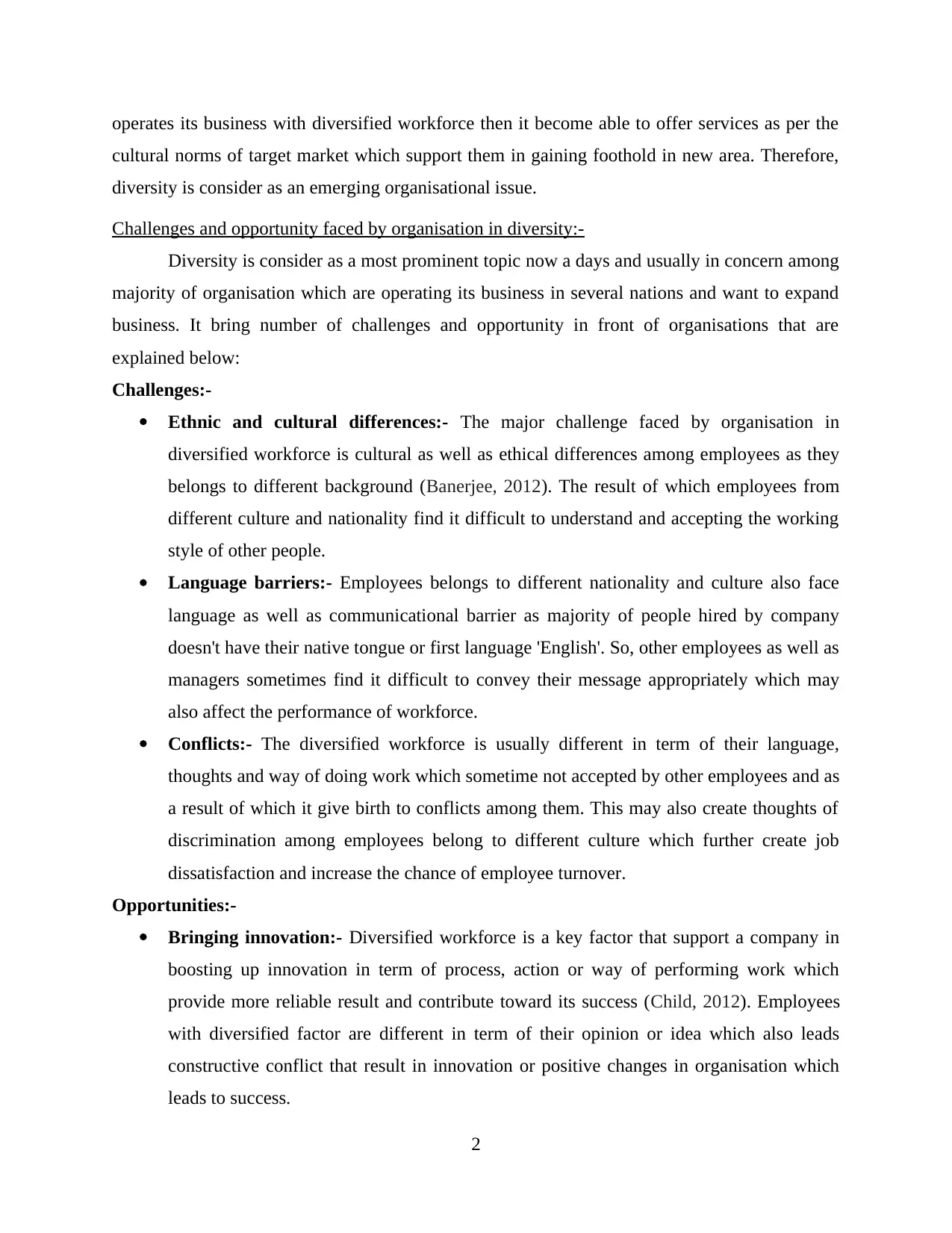
operates its business with diversified workforce then it become able to offer services as per the
cultural norms of target market which support them in gaining foothold in new area. Therefore,
diversity is consider as an emerging organisational issue.
Challenges and opportunity faced by organisation in diversity:-
Diversity is consider as a most prominent topic now a days and usually in concern among
majority of organisation which are operating its business in several nations and want to expand
business. It bring number of challenges and opportunity in front of organisations that are
explained below:
Challenges:-
Ethnic and cultural differences:- The major challenge faced by organisation in
diversified workforce is cultural as well as ethical differences among employees as they
belongs to different background (Banerjee, 2012). The result of which employees from
different culture and nationality find it difficult to understand and accepting the working
style of other people.
Language barriers:- Employees belongs to different nationality and culture also face
language as well as communicational barrier as majority of people hired by company
doesn't have their native tongue or first language 'English'. So, other employees as well as
managers sometimes find it difficult to convey their message appropriately which may
also affect the performance of workforce.
Conflicts:- The diversified workforce is usually different in term of their language,
thoughts and way of doing work which sometime not accepted by other employees and as
a result of which it give birth to conflicts among them. This may also create thoughts of
discrimination among employees belong to different culture which further create job
dissatisfaction and increase the chance of employee turnover.
Opportunities:-
Bringing innovation:- Diversified workforce is a key factor that support a company in
boosting up innovation in term of process, action or way of performing work which
provide more reliable result and contribute toward its success (Child, 2012). Employees
with diversified factor are different in term of their opinion or idea which also leads
constructive conflict that result in innovation or positive changes in organisation which
leads to success.
2
cultural norms of target market which support them in gaining foothold in new area. Therefore,
diversity is consider as an emerging organisational issue.
Challenges and opportunity faced by organisation in diversity:-
Diversity is consider as a most prominent topic now a days and usually in concern among
majority of organisation which are operating its business in several nations and want to expand
business. It bring number of challenges and opportunity in front of organisations that are
explained below:
Challenges:-
Ethnic and cultural differences:- The major challenge faced by organisation in
diversified workforce is cultural as well as ethical differences among employees as they
belongs to different background (Banerjee, 2012). The result of which employees from
different culture and nationality find it difficult to understand and accepting the working
style of other people.
Language barriers:- Employees belongs to different nationality and culture also face
language as well as communicational barrier as majority of people hired by company
doesn't have their native tongue or first language 'English'. So, other employees as well as
managers sometimes find it difficult to convey their message appropriately which may
also affect the performance of workforce.
Conflicts:- The diversified workforce is usually different in term of their language,
thoughts and way of doing work which sometime not accepted by other employees and as
a result of which it give birth to conflicts among them. This may also create thoughts of
discrimination among employees belong to different culture which further create job
dissatisfaction and increase the chance of employee turnover.
Opportunities:-
Bringing innovation:- Diversified workforce is a key factor that support a company in
boosting up innovation in term of process, action or way of performing work which
provide more reliable result and contribute toward its success (Child, 2012). Employees
with diversified factor are different in term of their opinion or idea which also leads
constructive conflict that result in innovation or positive changes in organisation which
leads to success.
2
Paraphrase This Document
Need a fresh take? Get an instant paraphrase of this document with our AI Paraphraser
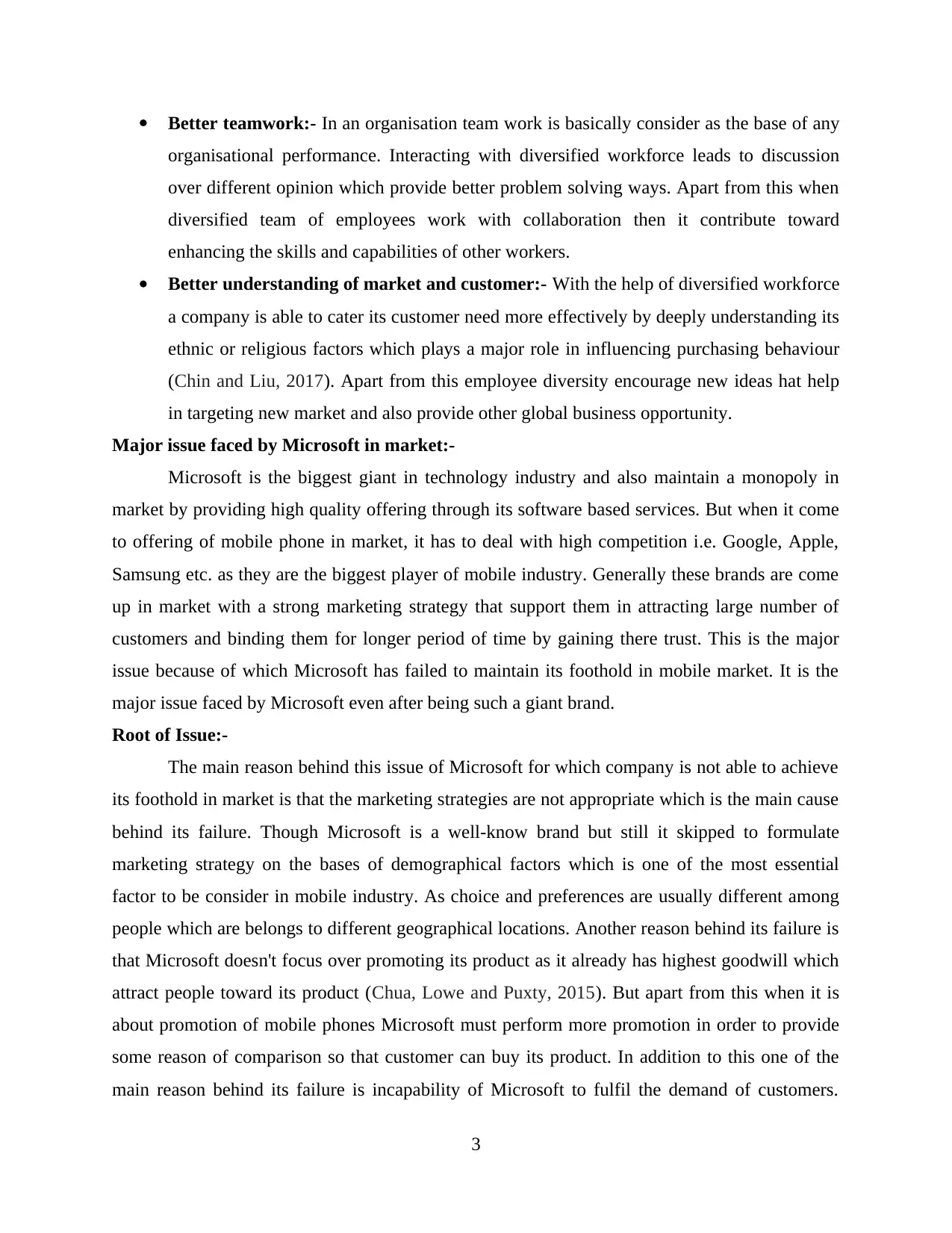
Better teamwork:- In an organisation team work is basically consider as the base of any
organisational performance. Interacting with diversified workforce leads to discussion
over different opinion which provide better problem solving ways. Apart from this when
diversified team of employees work with collaboration then it contribute toward
enhancing the skills and capabilities of other workers.
Better understanding of market and customer:- With the help of diversified workforce
a company is able to cater its customer need more effectively by deeply understanding its
ethnic or religious factors which plays a major role in influencing purchasing behaviour
(Chin and Liu, 2017). Apart from this employee diversity encourage new ideas hat help
in targeting new market and also provide other global business opportunity.
Major issue faced by Microsoft in market:-
Microsoft is the biggest giant in technology industry and also maintain a monopoly in
market by providing high quality offering through its software based services. But when it come
to offering of mobile phone in market, it has to deal with high competition i.e. Google, Apple,
Samsung etc. as they are the biggest player of mobile industry. Generally these brands are come
up in market with a strong marketing strategy that support them in attracting large number of
customers and binding them for longer period of time by gaining there trust. This is the major
issue because of which Microsoft has failed to maintain its foothold in mobile market. It is the
major issue faced by Microsoft even after being such a giant brand.
Root of Issue:-
The main reason behind this issue of Microsoft for which company is not able to achieve
its foothold in market is that the marketing strategies are not appropriate which is the main cause
behind its failure. Though Microsoft is a well-know brand but still it skipped to formulate
marketing strategy on the bases of demographical factors which is one of the most essential
factor to be consider in mobile industry. As choice and preferences are usually different among
people which are belongs to different geographical locations. Another reason behind its failure is
that Microsoft doesn't focus over promoting its product as it already has highest goodwill which
attract people toward its product (Chua, Lowe and Puxty, 2015). But apart from this when it is
about promotion of mobile phones Microsoft must perform more promotion in order to provide
some reason of comparison so that customer can buy its product. In addition to this one of the
main reason behind its failure is incapability of Microsoft to fulfil the demand of customers.
3
organisational performance. Interacting with diversified workforce leads to discussion
over different opinion which provide better problem solving ways. Apart from this when
diversified team of employees work with collaboration then it contribute toward
enhancing the skills and capabilities of other workers.
Better understanding of market and customer:- With the help of diversified workforce
a company is able to cater its customer need more effectively by deeply understanding its
ethnic or religious factors which plays a major role in influencing purchasing behaviour
(Chin and Liu, 2017). Apart from this employee diversity encourage new ideas hat help
in targeting new market and also provide other global business opportunity.
Major issue faced by Microsoft in market:-
Microsoft is the biggest giant in technology industry and also maintain a monopoly in
market by providing high quality offering through its software based services. But when it come
to offering of mobile phone in market, it has to deal with high competition i.e. Google, Apple,
Samsung etc. as they are the biggest player of mobile industry. Generally these brands are come
up in market with a strong marketing strategy that support them in attracting large number of
customers and binding them for longer period of time by gaining there trust. This is the major
issue because of which Microsoft has failed to maintain its foothold in mobile market. It is the
major issue faced by Microsoft even after being such a giant brand.
Root of Issue:-
The main reason behind this issue of Microsoft for which company is not able to achieve
its foothold in market is that the marketing strategies are not appropriate which is the main cause
behind its failure. Though Microsoft is a well-know brand but still it skipped to formulate
marketing strategy on the bases of demographical factors which is one of the most essential
factor to be consider in mobile industry. As choice and preferences are usually different among
people which are belongs to different geographical locations. Another reason behind its failure is
that Microsoft doesn't focus over promoting its product as it already has highest goodwill which
attract people toward its product (Chua, Lowe and Puxty, 2015). But apart from this when it is
about promotion of mobile phones Microsoft must perform more promotion in order to provide
some reason of comparison so that customer can buy its product. In addition to this one of the
main reason behind its failure is incapability of Microsoft to fulfil the demand of customers.
3
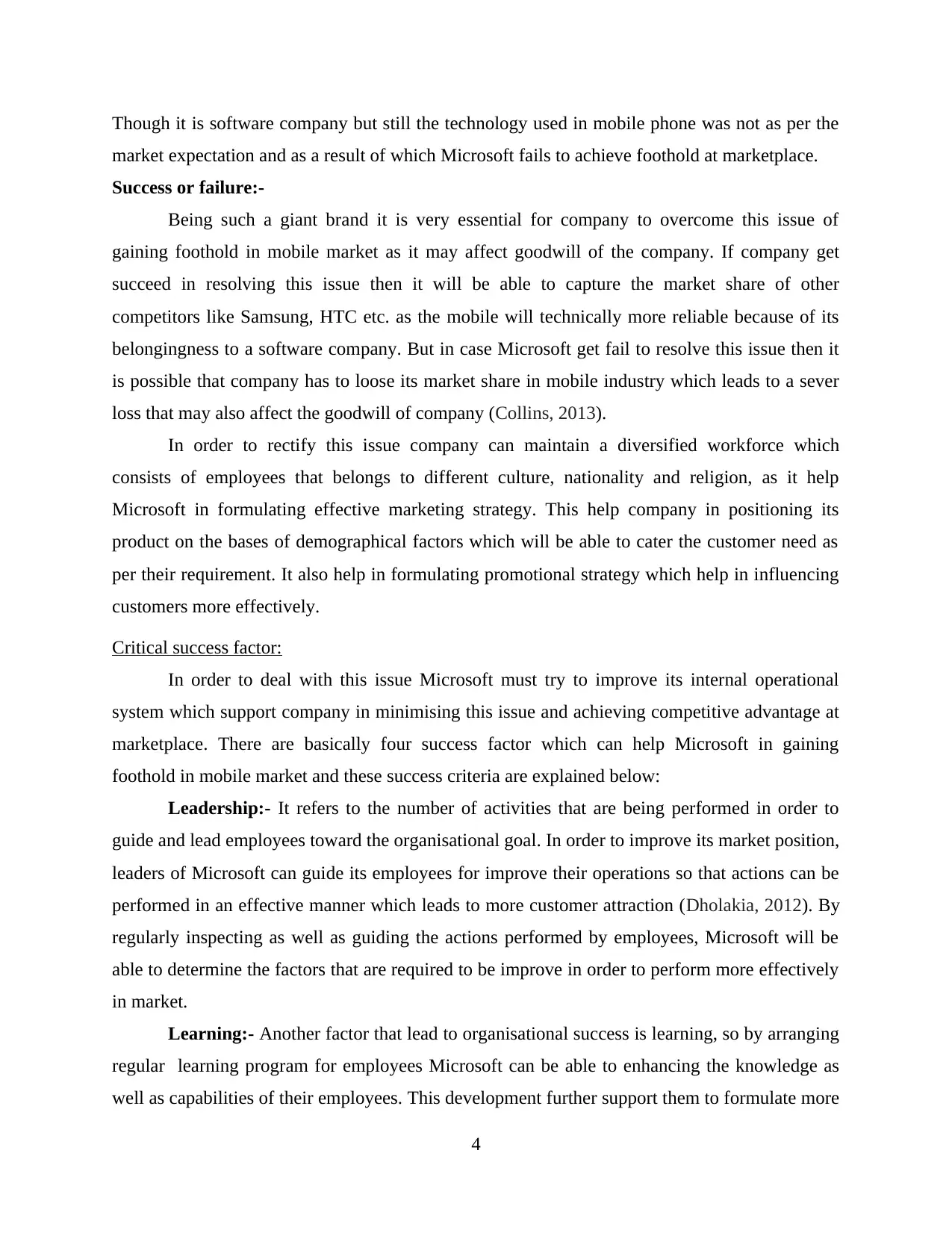
Though it is software company but still the technology used in mobile phone was not as per the
market expectation and as a result of which Microsoft fails to achieve foothold at marketplace.
Success or failure:-
Being such a giant brand it is very essential for company to overcome this issue of
gaining foothold in mobile market as it may affect goodwill of the company. If company get
succeed in resolving this issue then it will be able to capture the market share of other
competitors like Samsung, HTC etc. as the mobile will technically more reliable because of its
belongingness to a software company. But in case Microsoft get fail to resolve this issue then it
is possible that company has to loose its market share in mobile industry which leads to a sever
loss that may also affect the goodwill of company (Collins, 2013).
In order to rectify this issue company can maintain a diversified workforce which
consists of employees that belongs to different culture, nationality and religion, as it help
Microsoft in formulating effective marketing strategy. This help company in positioning its
product on the bases of demographical factors which will be able to cater the customer need as
per their requirement. It also help in formulating promotional strategy which help in influencing
customers more effectively.
Critical success factor:
In order to deal with this issue Microsoft must try to improve its internal operational
system which support company in minimising this issue and achieving competitive advantage at
marketplace. There are basically four success factor which can help Microsoft in gaining
foothold in mobile market and these success criteria are explained below:
Leadership:- It refers to the number of activities that are being performed in order to
guide and lead employees toward the organisational goal. In order to improve its market position,
leaders of Microsoft can guide its employees for improve their operations so that actions can be
performed in an effective manner which leads to more customer attraction (Dholakia, 2012). By
regularly inspecting as well as guiding the actions performed by employees, Microsoft will be
able to determine the factors that are required to be improve in order to perform more effectively
in market.
Learning:- Another factor that lead to organisational success is learning, so by arranging
regular learning program for employees Microsoft can be able to enhancing the knowledge as
well as capabilities of their employees. This development further support them to formulate more
4
market expectation and as a result of which Microsoft fails to achieve foothold at marketplace.
Success or failure:-
Being such a giant brand it is very essential for company to overcome this issue of
gaining foothold in mobile market as it may affect goodwill of the company. If company get
succeed in resolving this issue then it will be able to capture the market share of other
competitors like Samsung, HTC etc. as the mobile will technically more reliable because of its
belongingness to a software company. But in case Microsoft get fail to resolve this issue then it
is possible that company has to loose its market share in mobile industry which leads to a sever
loss that may also affect the goodwill of company (Collins, 2013).
In order to rectify this issue company can maintain a diversified workforce which
consists of employees that belongs to different culture, nationality and religion, as it help
Microsoft in formulating effective marketing strategy. This help company in positioning its
product on the bases of demographical factors which will be able to cater the customer need as
per their requirement. It also help in formulating promotional strategy which help in influencing
customers more effectively.
Critical success factor:
In order to deal with this issue Microsoft must try to improve its internal operational
system which support company in minimising this issue and achieving competitive advantage at
marketplace. There are basically four success factor which can help Microsoft in gaining
foothold in mobile market and these success criteria are explained below:
Leadership:- It refers to the number of activities that are being performed in order to
guide and lead employees toward the organisational goal. In order to improve its market position,
leaders of Microsoft can guide its employees for improve their operations so that actions can be
performed in an effective manner which leads to more customer attraction (Dholakia, 2012). By
regularly inspecting as well as guiding the actions performed by employees, Microsoft will be
able to determine the factors that are required to be improve in order to perform more effectively
in market.
Learning:- Another factor that lead to organisational success is learning, so by arranging
regular learning program for employees Microsoft can be able to enhancing the knowledge as
well as capabilities of their employees. This development further support them to formulate more
4
⊘ This is a preview!⊘
Do you want full access?
Subscribe today to unlock all pages.

Trusted by 1+ million students worldwide
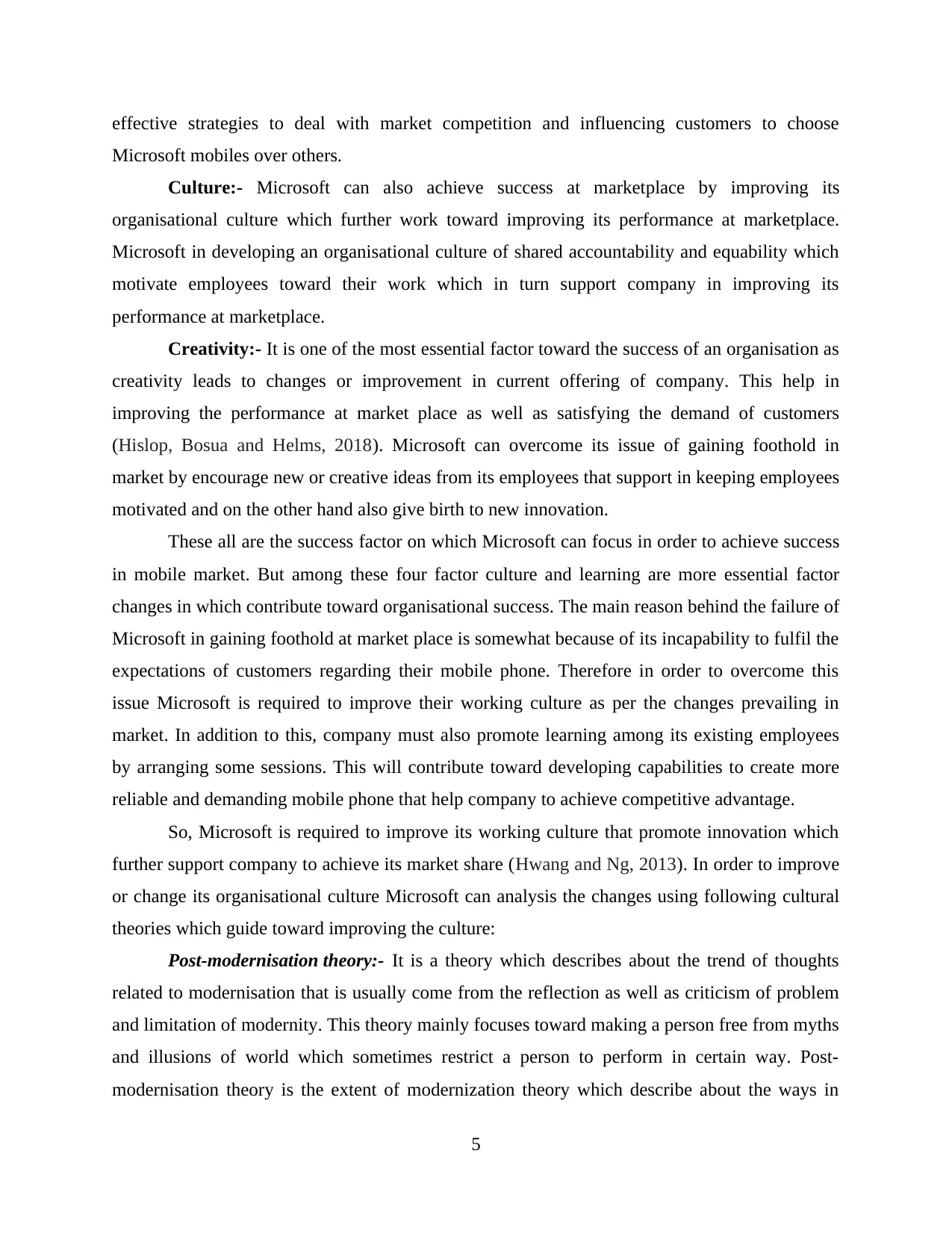
effective strategies to deal with market competition and influencing customers to choose
Microsoft mobiles over others.
Culture:- Microsoft can also achieve success at marketplace by improving its
organisational culture which further work toward improving its performance at marketplace.
Microsoft in developing an organisational culture of shared accountability and equability which
motivate employees toward their work which in turn support company in improving its
performance at marketplace.
Creativity:- It is one of the most essential factor toward the success of an organisation as
creativity leads to changes or improvement in current offering of company. This help in
improving the performance at market place as well as satisfying the demand of customers
(Hislop, Bosua and Helms, 2018). Microsoft can overcome its issue of gaining foothold in
market by encourage new or creative ideas from its employees that support in keeping employees
motivated and on the other hand also give birth to new innovation.
These all are the success factor on which Microsoft can focus in order to achieve success
in mobile market. But among these four factor culture and learning are more essential factor
changes in which contribute toward organisational success. The main reason behind the failure of
Microsoft in gaining foothold at market place is somewhat because of its incapability to fulfil the
expectations of customers regarding their mobile phone. Therefore in order to overcome this
issue Microsoft is required to improve their working culture as per the changes prevailing in
market. In addition to this, company must also promote learning among its existing employees
by arranging some sessions. This will contribute toward developing capabilities to create more
reliable and demanding mobile phone that help company to achieve competitive advantage.
So, Microsoft is required to improve its working culture that promote innovation which
further support company to achieve its market share (Hwang and Ng, 2013). In order to improve
or change its organisational culture Microsoft can analysis the changes using following cultural
theories which guide toward improving the culture:
Post-modernisation theory:- It is a theory which describes about the trend of thoughts
related to modernisation that is usually come from the reflection as well as criticism of problem
and limitation of modernity. This theory mainly focuses toward making a person free from myths
and illusions of world which sometimes restrict a person to perform in certain way. Post-
modernisation theory is the extent of modernization theory which describe about the ways in
5
Microsoft mobiles over others.
Culture:- Microsoft can also achieve success at marketplace by improving its
organisational culture which further work toward improving its performance at marketplace.
Microsoft in developing an organisational culture of shared accountability and equability which
motivate employees toward their work which in turn support company in improving its
performance at marketplace.
Creativity:- It is one of the most essential factor toward the success of an organisation as
creativity leads to changes or improvement in current offering of company. This help in
improving the performance at market place as well as satisfying the demand of customers
(Hislop, Bosua and Helms, 2018). Microsoft can overcome its issue of gaining foothold in
market by encourage new or creative ideas from its employees that support in keeping employees
motivated and on the other hand also give birth to new innovation.
These all are the success factor on which Microsoft can focus in order to achieve success
in mobile market. But among these four factor culture and learning are more essential factor
changes in which contribute toward organisational success. The main reason behind the failure of
Microsoft in gaining foothold at market place is somewhat because of its incapability to fulfil the
expectations of customers regarding their mobile phone. Therefore in order to overcome this
issue Microsoft is required to improve their working culture as per the changes prevailing in
market. In addition to this, company must also promote learning among its existing employees
by arranging some sessions. This will contribute toward developing capabilities to create more
reliable and demanding mobile phone that help company to achieve competitive advantage.
So, Microsoft is required to improve its working culture that promote innovation which
further support company to achieve its market share (Hwang and Ng, 2013). In order to improve
or change its organisational culture Microsoft can analysis the changes using following cultural
theories which guide toward improving the culture:
Post-modernisation theory:- It is a theory which describes about the trend of thoughts
related to modernisation that is usually come from the reflection as well as criticism of problem
and limitation of modernity. This theory mainly focuses toward making a person free from myths
and illusions of world which sometimes restrict a person to perform in certain way. Post-
modernisation theory is the extent of modernization theory which describe about the ways in
5
Paraphrase This Document
Need a fresh take? Get an instant paraphrase of this document with our AI Paraphraser
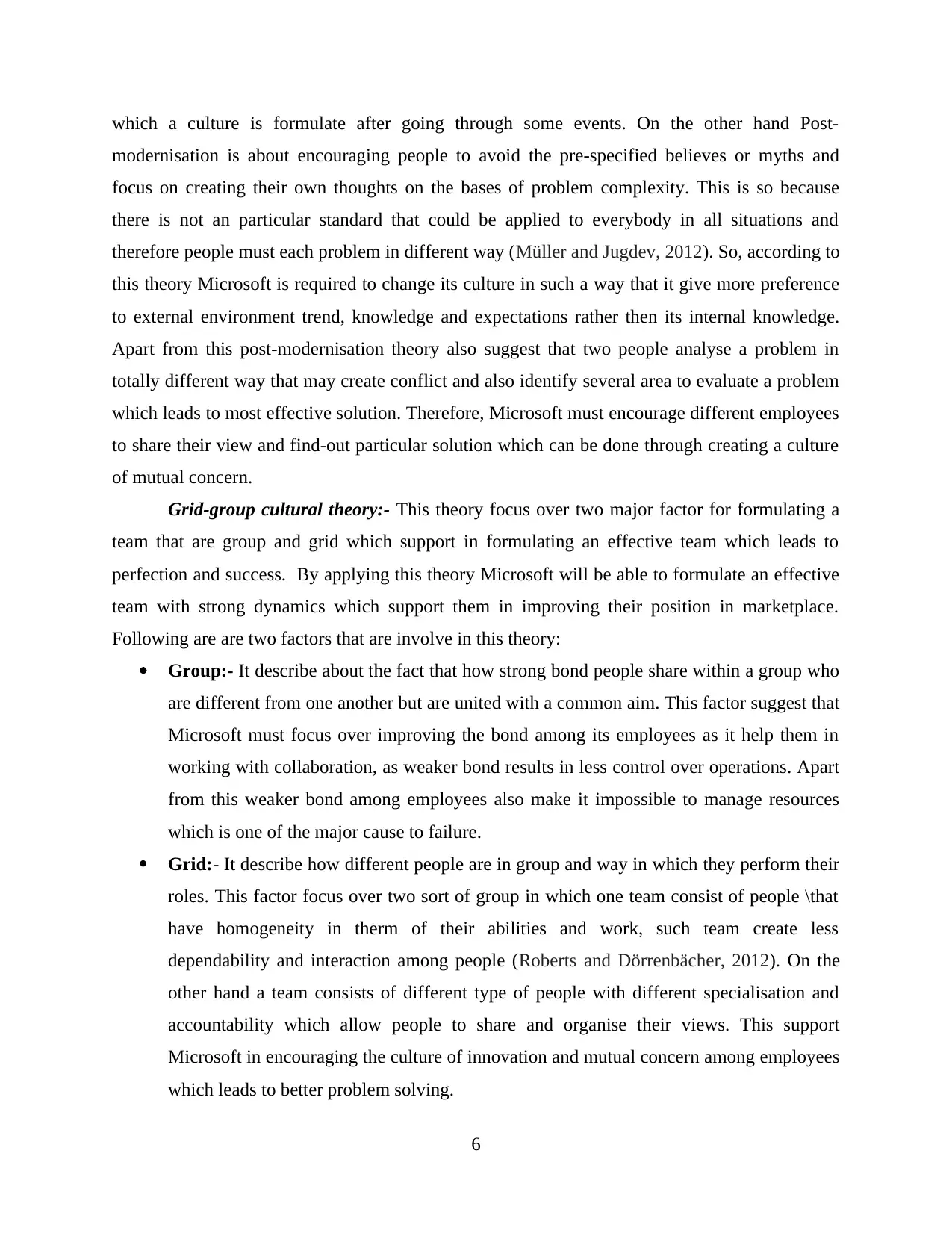
which a culture is formulate after going through some events. On the other hand Post-
modernisation is about encouraging people to avoid the pre-specified believes or myths and
focus on creating their own thoughts on the bases of problem complexity. This is so because
there is not an particular standard that could be applied to everybody in all situations and
therefore people must each problem in different way (Müller and Jugdev, 2012). So, according to
this theory Microsoft is required to change its culture in such a way that it give more preference
to external environment trend, knowledge and expectations rather then its internal knowledge.
Apart from this post-modernisation theory also suggest that two people analyse a problem in
totally different way that may create conflict and also identify several area to evaluate a problem
which leads to most effective solution. Therefore, Microsoft must encourage different employees
to share their view and find-out particular solution which can be done through creating a culture
of mutual concern.
Grid-group cultural theory:- This theory focus over two major factor for formulating a
team that are group and grid which support in formulating an effective team which leads to
perfection and success. By applying this theory Microsoft will be able to formulate an effective
team with strong dynamics which support them in improving their position in marketplace.
Following are are two factors that are involve in this theory:
Group:- It describe about the fact that how strong bond people share within a group who
are different from one another but are united with a common aim. This factor suggest that
Microsoft must focus over improving the bond among its employees as it help them in
working with collaboration, as weaker bond results in less control over operations. Apart
from this weaker bond among employees also make it impossible to manage resources
which is one of the major cause to failure.
Grid:- It describe how different people are in group and way in which they perform their
roles. This factor focus over two sort of group in which one team consist of people \that
have homogeneity in therm of their abilities and work, such team create less
dependability and interaction among people (Roberts and Dörrenbächer, 2012). On the
other hand a team consists of different type of people with different specialisation and
accountability which allow people to share and organise their views. This support
Microsoft in encouraging the culture of innovation and mutual concern among employees
which leads to better problem solving.
6
modernisation is about encouraging people to avoid the pre-specified believes or myths and
focus on creating their own thoughts on the bases of problem complexity. This is so because
there is not an particular standard that could be applied to everybody in all situations and
therefore people must each problem in different way (Müller and Jugdev, 2012). So, according to
this theory Microsoft is required to change its culture in such a way that it give more preference
to external environment trend, knowledge and expectations rather then its internal knowledge.
Apart from this post-modernisation theory also suggest that two people analyse a problem in
totally different way that may create conflict and also identify several area to evaluate a problem
which leads to most effective solution. Therefore, Microsoft must encourage different employees
to share their view and find-out particular solution which can be done through creating a culture
of mutual concern.
Grid-group cultural theory:- This theory focus over two major factor for formulating a
team that are group and grid which support in formulating an effective team which leads to
perfection and success. By applying this theory Microsoft will be able to formulate an effective
team with strong dynamics which support them in improving their position in marketplace.
Following are are two factors that are involve in this theory:
Group:- It describe about the fact that how strong bond people share within a group who
are different from one another but are united with a common aim. This factor suggest that
Microsoft must focus over improving the bond among its employees as it help them in
working with collaboration, as weaker bond results in less control over operations. Apart
from this weaker bond among employees also make it impossible to manage resources
which is one of the major cause to failure.
Grid:- It describe how different people are in group and way in which they perform their
roles. This factor focus over two sort of group in which one team consist of people \that
have homogeneity in therm of their abilities and work, such team create less
dependability and interaction among people (Roberts and Dörrenbächer, 2012). On the
other hand a team consists of different type of people with different specialisation and
accountability which allow people to share and organise their views. This support
Microsoft in encouraging the culture of innovation and mutual concern among employees
which leads to better problem solving.
6
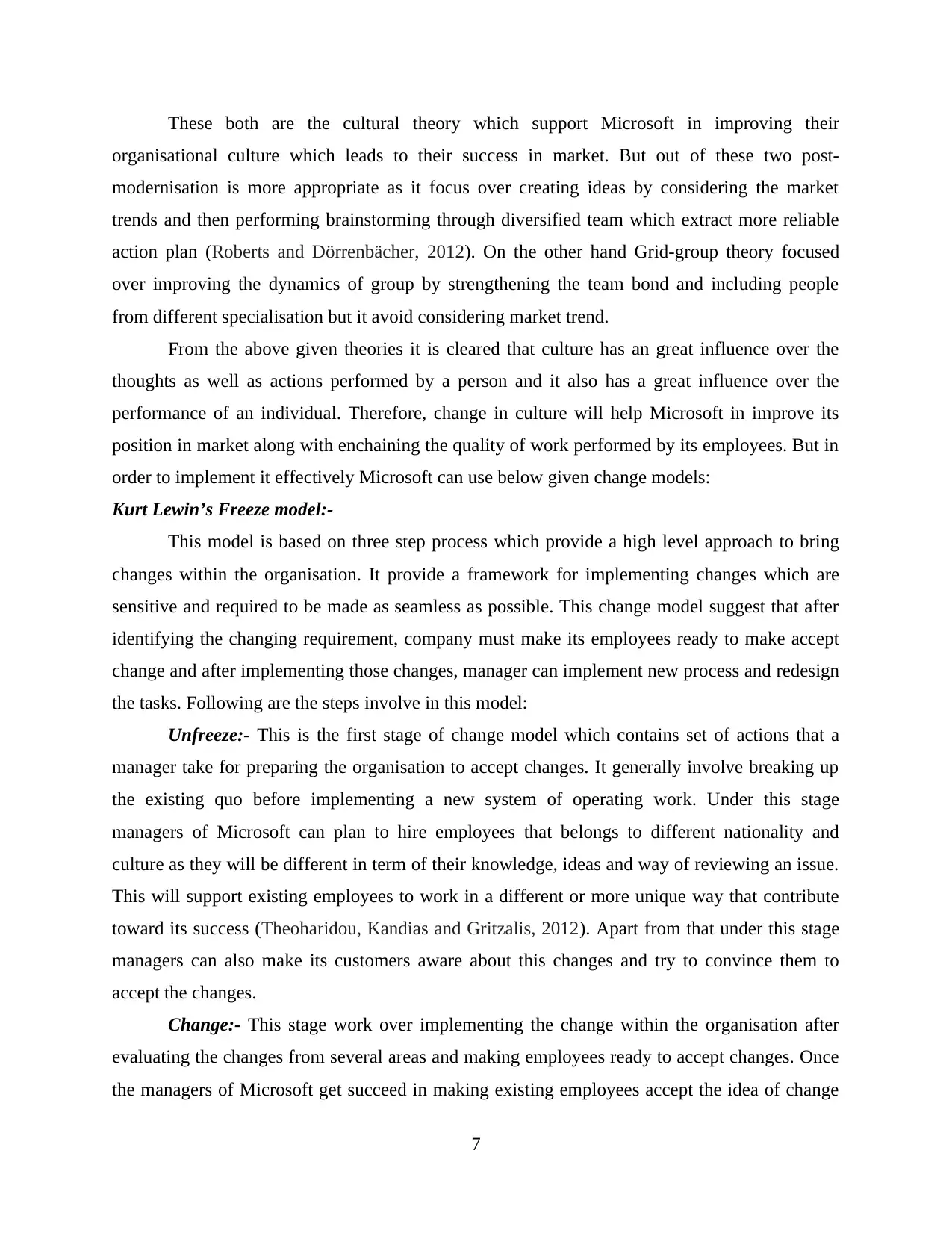
These both are the cultural theory which support Microsoft in improving their
organisational culture which leads to their success in market. But out of these two post-
modernisation is more appropriate as it focus over creating ideas by considering the market
trends and then performing brainstorming through diversified team which extract more reliable
action plan (Roberts and Dörrenbächer, 2012). On the other hand Grid-group theory focused
over improving the dynamics of group by strengthening the team bond and including people
from different specialisation but it avoid considering market trend.
From the above given theories it is cleared that culture has an great influence over the
thoughts as well as actions performed by a person and it also has a great influence over the
performance of an individual. Therefore, change in culture will help Microsoft in improve its
position in market along with enchaining the quality of work performed by its employees. But in
order to implement it effectively Microsoft can use below given change models:
Kurt Lewin’s Freeze model:-
This model is based on three step process which provide a high level approach to bring
changes within the organisation. It provide a framework for implementing changes which are
sensitive and required to be made as seamless as possible. This change model suggest that after
identifying the changing requirement, company must make its employees ready to make accept
change and after implementing those changes, manager can implement new process and redesign
the tasks. Following are the steps involve in this model:
Unfreeze:- This is the first stage of change model which contains set of actions that a
manager take for preparing the organisation to accept changes. It generally involve breaking up
the existing quo before implementing a new system of operating work. Under this stage
managers of Microsoft can plan to hire employees that belongs to different nationality and
culture as they will be different in term of their knowledge, ideas and way of reviewing an issue.
This will support existing employees to work in a different or more unique way that contribute
toward its success (Theoharidou, Kandias and Gritzalis, 2012). Apart from that under this stage
managers can also make its customers aware about this changes and try to convince them to
accept the changes.
Change:- This stage work over implementing the change within the organisation after
evaluating the changes from several areas and making employees ready to accept changes. Once
the managers of Microsoft get succeed in making existing employees accept the idea of change
7
organisational culture which leads to their success in market. But out of these two post-
modernisation is more appropriate as it focus over creating ideas by considering the market
trends and then performing brainstorming through diversified team which extract more reliable
action plan (Roberts and Dörrenbächer, 2012). On the other hand Grid-group theory focused
over improving the dynamics of group by strengthening the team bond and including people
from different specialisation but it avoid considering market trend.
From the above given theories it is cleared that culture has an great influence over the
thoughts as well as actions performed by a person and it also has a great influence over the
performance of an individual. Therefore, change in culture will help Microsoft in improve its
position in market along with enchaining the quality of work performed by its employees. But in
order to implement it effectively Microsoft can use below given change models:
Kurt Lewin’s Freeze model:-
This model is based on three step process which provide a high level approach to bring
changes within the organisation. It provide a framework for implementing changes which are
sensitive and required to be made as seamless as possible. This change model suggest that after
identifying the changing requirement, company must make its employees ready to make accept
change and after implementing those changes, manager can implement new process and redesign
the tasks. Following are the steps involve in this model:
Unfreeze:- This is the first stage of change model which contains set of actions that a
manager take for preparing the organisation to accept changes. It generally involve breaking up
the existing quo before implementing a new system of operating work. Under this stage
managers of Microsoft can plan to hire employees that belongs to different nationality and
culture as they will be different in term of their knowledge, ideas and way of reviewing an issue.
This will support existing employees to work in a different or more unique way that contribute
toward its success (Theoharidou, Kandias and Gritzalis, 2012). Apart from that under this stage
managers can also make its customers aware about this changes and try to convince them to
accept the changes.
Change:- This stage work over implementing the change within the organisation after
evaluating the changes from several areas and making employees ready to accept changes. Once
the managers of Microsoft get succeed in making existing employees accept the idea of change
7
⊘ This is a preview!⊘
Do you want full access?
Subscribe today to unlock all pages.

Trusted by 1+ million students worldwide
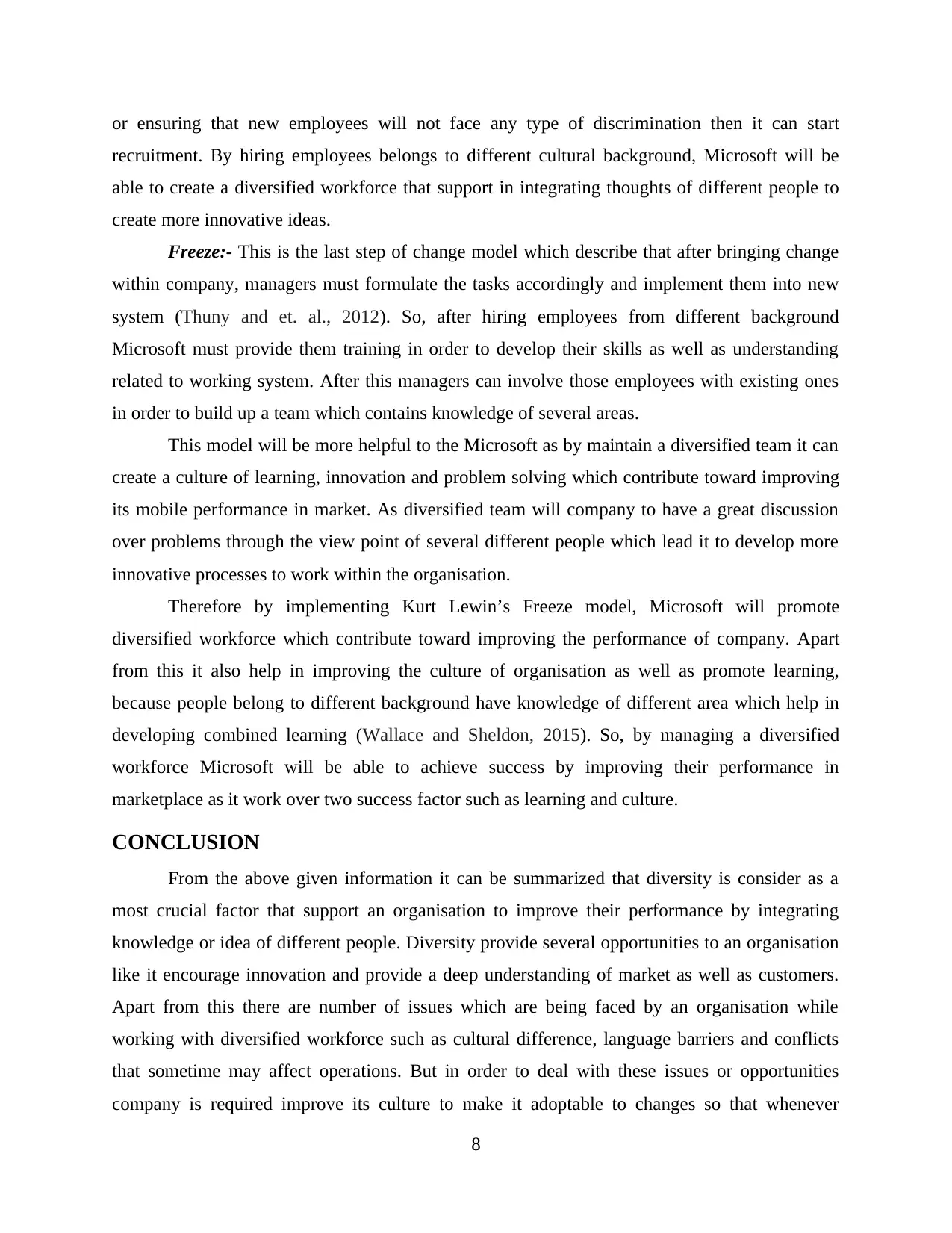
or ensuring that new employees will not face any type of discrimination then it can start
recruitment. By hiring employees belongs to different cultural background, Microsoft will be
able to create a diversified workforce that support in integrating thoughts of different people to
create more innovative ideas.
Freeze:- This is the last step of change model which describe that after bringing change
within company, managers must formulate the tasks accordingly and implement them into new
system (Thuny and et. al., 2012). So, after hiring employees from different background
Microsoft must provide them training in order to develop their skills as well as understanding
related to working system. After this managers can involve those employees with existing ones
in order to build up a team which contains knowledge of several areas.
This model will be more helpful to the Microsoft as by maintain a diversified team it can
create a culture of learning, innovation and problem solving which contribute toward improving
its mobile performance in market. As diversified team will company to have a great discussion
over problems through the view point of several different people which lead it to develop more
innovative processes to work within the organisation.
Therefore by implementing Kurt Lewin’s Freeze model, Microsoft will promote
diversified workforce which contribute toward improving the performance of company. Apart
from this it also help in improving the culture of organisation as well as promote learning,
because people belong to different background have knowledge of different area which help in
developing combined learning (Wallace and Sheldon, 2015). So, by managing a diversified
workforce Microsoft will be able to achieve success by improving their performance in
marketplace as it work over two success factor such as learning and culture.
CONCLUSION
From the above given information it can be summarized that diversity is consider as a
most crucial factor that support an organisation to improve their performance by integrating
knowledge or idea of different people. Diversity provide several opportunities to an organisation
like it encourage innovation and provide a deep understanding of market as well as customers.
Apart from this there are number of issues which are being faced by an organisation while
working with diversified workforce such as cultural difference, language barriers and conflicts
that sometime may affect operations. But in order to deal with these issues or opportunities
company is required improve its culture to make it adoptable to changes so that whenever
8
recruitment. By hiring employees belongs to different cultural background, Microsoft will be
able to create a diversified workforce that support in integrating thoughts of different people to
create more innovative ideas.
Freeze:- This is the last step of change model which describe that after bringing change
within company, managers must formulate the tasks accordingly and implement them into new
system (Thuny and et. al., 2012). So, after hiring employees from different background
Microsoft must provide them training in order to develop their skills as well as understanding
related to working system. After this managers can involve those employees with existing ones
in order to build up a team which contains knowledge of several areas.
This model will be more helpful to the Microsoft as by maintain a diversified team it can
create a culture of learning, innovation and problem solving which contribute toward improving
its mobile performance in market. As diversified team will company to have a great discussion
over problems through the view point of several different people which lead it to develop more
innovative processes to work within the organisation.
Therefore by implementing Kurt Lewin’s Freeze model, Microsoft will promote
diversified workforce which contribute toward improving the performance of company. Apart
from this it also help in improving the culture of organisation as well as promote learning,
because people belong to different background have knowledge of different area which help in
developing combined learning (Wallace and Sheldon, 2015). So, by managing a diversified
workforce Microsoft will be able to achieve success by improving their performance in
marketplace as it work over two success factor such as learning and culture.
CONCLUSION
From the above given information it can be summarized that diversity is consider as a
most crucial factor that support an organisation to improve their performance by integrating
knowledge or idea of different people. Diversity provide several opportunities to an organisation
like it encourage innovation and provide a deep understanding of market as well as customers.
Apart from this there are number of issues which are being faced by an organisation while
working with diversified workforce such as cultural difference, language barriers and conflicts
that sometime may affect operations. But in order to deal with these issues or opportunities
company is required improve its culture to make it adoptable to changes so that whenever
8
Paraphrase This Document
Need a fresh take? Get an instant paraphrase of this document with our AI Paraphraser
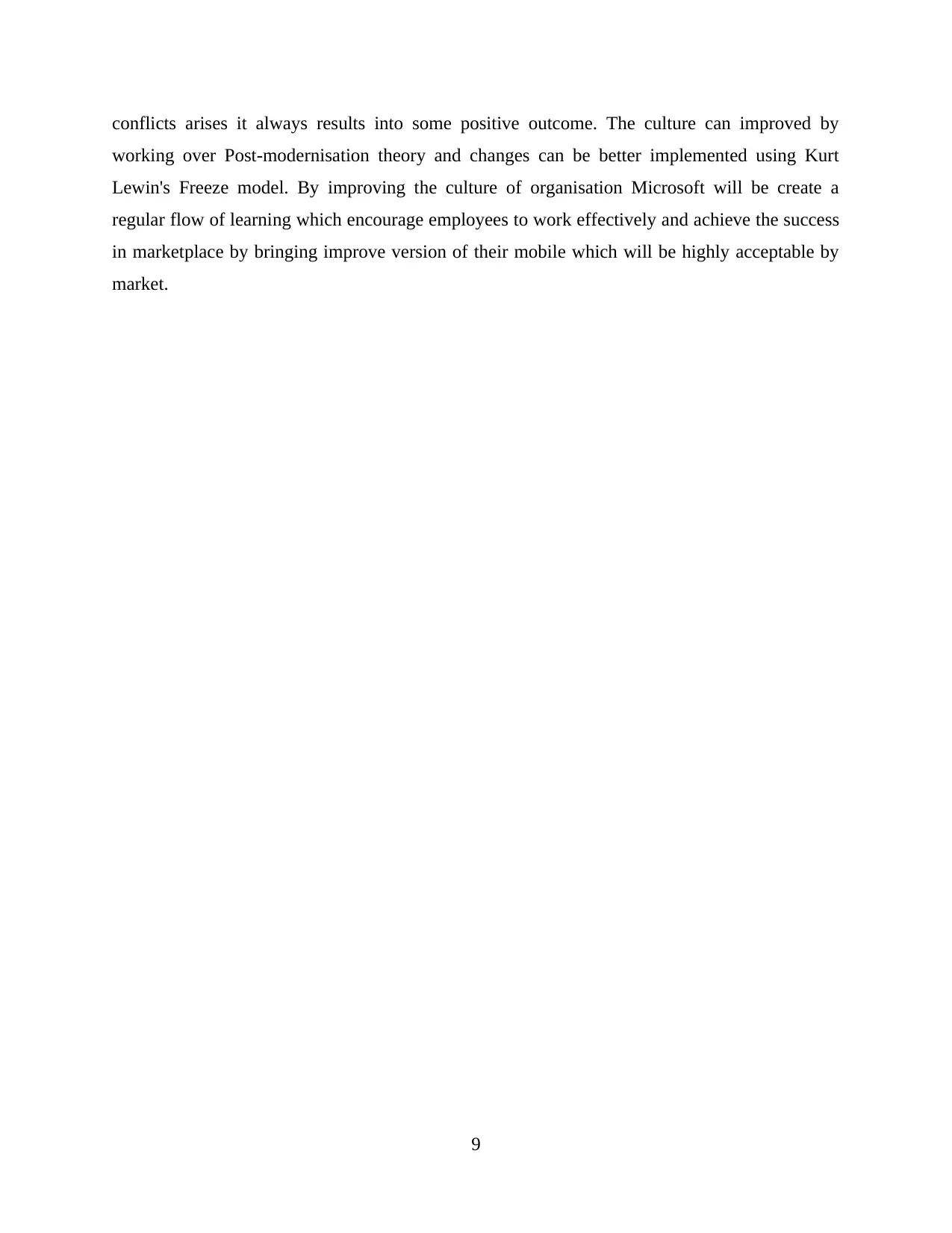
conflicts arises it always results into some positive outcome. The culture can improved by
working over Post-modernisation theory and changes can be better implemented using Kurt
Lewin's Freeze model. By improving the culture of organisation Microsoft will be create a
regular flow of learning which encourage employees to work effectively and achieve the success
in marketplace by bringing improve version of their mobile which will be highly acceptable by
market.
9
working over Post-modernisation theory and changes can be better implemented using Kurt
Lewin's Freeze model. By improving the culture of organisation Microsoft will be create a
regular flow of learning which encourage employees to work effectively and achieve the success
in marketplace by bringing improve version of their mobile which will be highly acceptable by
market.
9
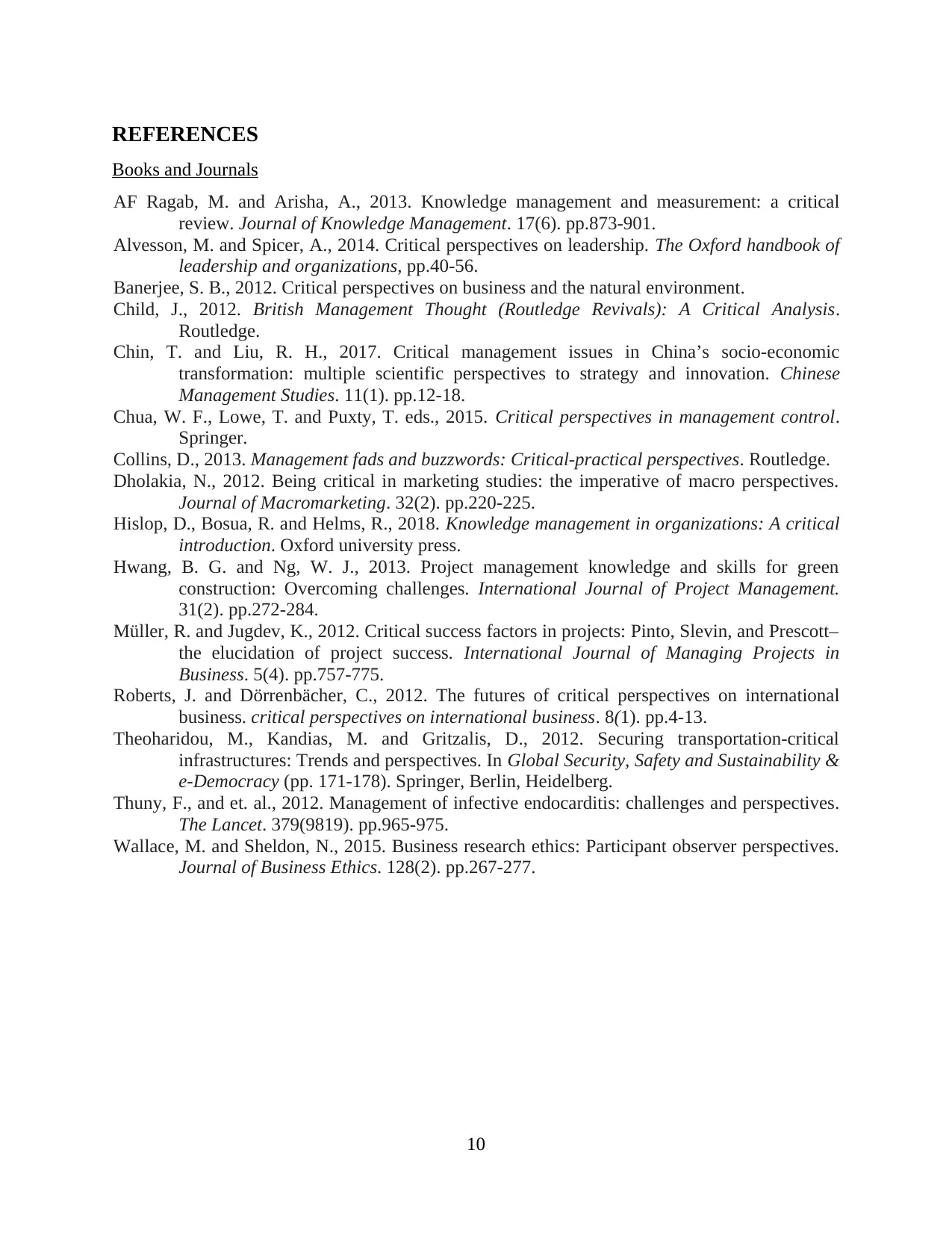
REFERENCES
Books and Journals
AF Ragab, M. and Arisha, A., 2013. Knowledge management and measurement: a critical
review. Journal of Knowledge Management. 17(6). pp.873-901.
Alvesson, M. and Spicer, A., 2014. Critical perspectives on leadership. The Oxford handbook of
leadership and organizations, pp.40-56.
Banerjee, S. B., 2012. Critical perspectives on business and the natural environment.
Child, J., 2012. British Management Thought (Routledge Revivals): A Critical Analysis.
Routledge.
Chin, T. and Liu, R. H., 2017. Critical management issues in China’s socio-economic
transformation: multiple scientific perspectives to strategy and innovation. Chinese
Management Studies. 11(1). pp.12-18.
Chua, W. F., Lowe, T. and Puxty, T. eds., 2015. Critical perspectives in management control.
Springer.
Collins, D., 2013. Management fads and buzzwords: Critical-practical perspectives. Routledge.
Dholakia, N., 2012. Being critical in marketing studies: the imperative of macro perspectives.
Journal of Macromarketing. 32(2). pp.220-225.
Hislop, D., Bosua, R. and Helms, R., 2018. Knowledge management in organizations: A critical
introduction. Oxford university press.
Hwang, B. G. and Ng, W. J., 2013. Project management knowledge and skills for green
construction: Overcoming challenges. International Journal of Project Management.
31(2). pp.272-284.
Müller, R. and Jugdev, K., 2012. Critical success factors in projects: Pinto, Slevin, and Prescott–
the elucidation of project success. International Journal of Managing Projects in
Business. 5(4). pp.757-775.
Roberts, J. and Dörrenbächer, C., 2012. The futures of critical perspectives on international
business. critical perspectives on international business. 8(1). pp.4-13.
Theoharidou, M., Kandias, M. and Gritzalis, D., 2012. Securing transportation-critical
infrastructures: Trends and perspectives. In Global Security, Safety and Sustainability &
e-Democracy (pp. 171-178). Springer, Berlin, Heidelberg.
Thuny, F., and et. al., 2012. Management of infective endocarditis: challenges and perspectives.
The Lancet. 379(9819). pp.965-975.
Wallace, M. and Sheldon, N., 2015. Business research ethics: Participant observer perspectives.
Journal of Business Ethics. 128(2). pp.267-277.
10
Books and Journals
AF Ragab, M. and Arisha, A., 2013. Knowledge management and measurement: a critical
review. Journal of Knowledge Management. 17(6). pp.873-901.
Alvesson, M. and Spicer, A., 2014. Critical perspectives on leadership. The Oxford handbook of
leadership and organizations, pp.40-56.
Banerjee, S. B., 2012. Critical perspectives on business and the natural environment.
Child, J., 2012. British Management Thought (Routledge Revivals): A Critical Analysis.
Routledge.
Chin, T. and Liu, R. H., 2017. Critical management issues in China’s socio-economic
transformation: multiple scientific perspectives to strategy and innovation. Chinese
Management Studies. 11(1). pp.12-18.
Chua, W. F., Lowe, T. and Puxty, T. eds., 2015. Critical perspectives in management control.
Springer.
Collins, D., 2013. Management fads and buzzwords: Critical-practical perspectives. Routledge.
Dholakia, N., 2012. Being critical in marketing studies: the imperative of macro perspectives.
Journal of Macromarketing. 32(2). pp.220-225.
Hislop, D., Bosua, R. and Helms, R., 2018. Knowledge management in organizations: A critical
introduction. Oxford university press.
Hwang, B. G. and Ng, W. J., 2013. Project management knowledge and skills for green
construction: Overcoming challenges. International Journal of Project Management.
31(2). pp.272-284.
Müller, R. and Jugdev, K., 2012. Critical success factors in projects: Pinto, Slevin, and Prescott–
the elucidation of project success. International Journal of Managing Projects in
Business. 5(4). pp.757-775.
Roberts, J. and Dörrenbächer, C., 2012. The futures of critical perspectives on international
business. critical perspectives on international business. 8(1). pp.4-13.
Theoharidou, M., Kandias, M. and Gritzalis, D., 2012. Securing transportation-critical
infrastructures: Trends and perspectives. In Global Security, Safety and Sustainability &
e-Democracy (pp. 171-178). Springer, Berlin, Heidelberg.
Thuny, F., and et. al., 2012. Management of infective endocarditis: challenges and perspectives.
The Lancet. 379(9819). pp.965-975.
Wallace, M. and Sheldon, N., 2015. Business research ethics: Participant observer perspectives.
Journal of Business Ethics. 128(2). pp.267-277.
10
⊘ This is a preview!⊘
Do you want full access?
Subscribe today to unlock all pages.

Trusted by 1+ million students worldwide
1 out of 12
Related Documents
Your All-in-One AI-Powered Toolkit for Academic Success.
+13062052269
info@desklib.com
Available 24*7 on WhatsApp / Email
![[object Object]](/_next/static/media/star-bottom.7253800d.svg)
Unlock your academic potential
Copyright © 2020–2025 A2Z Services. All Rights Reserved. Developed and managed by ZUCOL.





